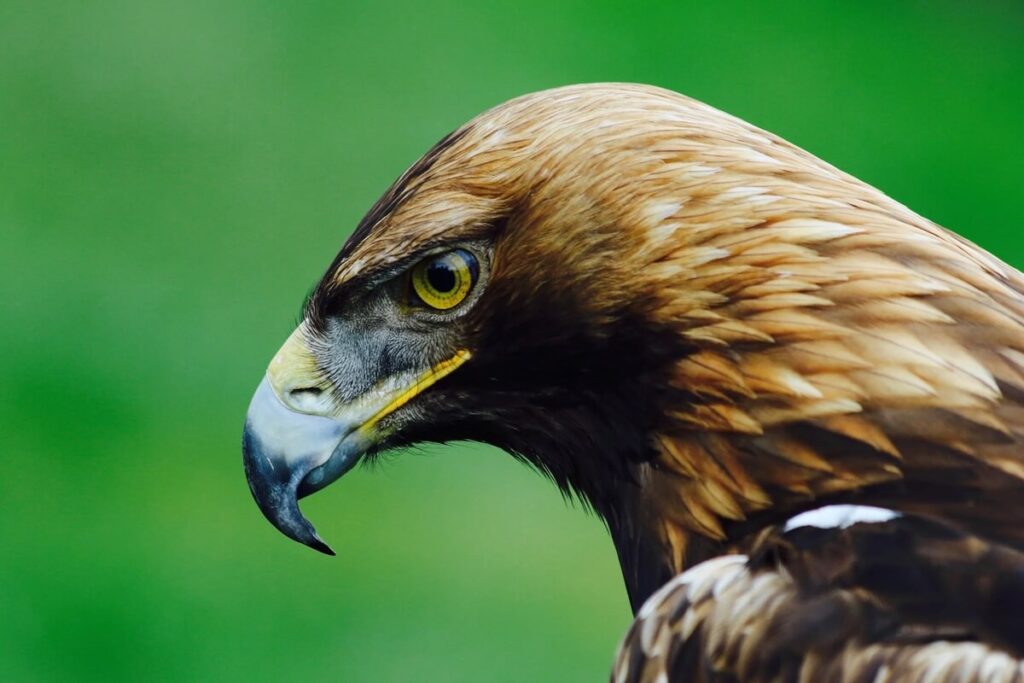High in the skies and deep in the annals of human history, eagles have always held a special place in our hearts and imaginations. With their awe-inspiring size, razor-sharp talons, and keen eyesight, these majestic birds of prey have captured the human spirit for centuries. So, spread your wings and join us as we soar into the fascinating realm of eagle facts and wonder.

Basics of Eagles
Eagles, with their awe-inspiring presence, have been revered throughout history as symbols of power, freedom, and magnificence. These majestic birds of prey belong to the Accipitridae family, boasting an impressive diversity of approximately 60 different species. While the majority of these noble creatures call Eurasia and Africa home, only 14 species can be found in other regions, including North, Central, and South America, as well as Australia.

Eagle Sight
Despite their relatively modest weight, averaging around 10 pounds, eagles possess a remarkable visual prowess. Their eyes are equivalent in size to those of humans, but their eyesight is estimated to be four to eight times more efficient than that of the average person, allowing them to spot objects up to three miles away and can discern five fundamental colors and possess the capability to perceive ultraviolet (UV) light.
Eagle Diet
Eagles are renowned for their ability to adapt their diet to various circumstances. During times of scarcity, they can survive for weeks without food. However, when food is scarce, a chilling phenomenon occurs. Unable to endure hunger, young eagles may resort to siblicide, where the stronger eaglet eliminates its weaker sibling for sustenance. This gruesome act is a desperate measure to ensure survival.

Eagle Communication
While eagles are typically solitary creatures due to their territorial nature, they come together during non-breeding periods, forming groups ranging from several birds to gatherings of hundreds. Scientists believe these gatherings serve as opportunities for socialization and information exchange regarding prey availability and locations. To communicate, they emit a range of high-pitched vocalizations, a surprising contrast to their robust stature.
Eagle mating
Eagles are known for their lifelong commitment to a single mate. They return to the same nest year after year, often located in inaccessible places. The incubation period for their small clutch of eggs lasts six to eight weeks, and it takes several years for the young eagles to reach their full adult plumage.
Eaglets, the offspring of eagles, are vulnerable to siblicide during times of food scarcity. To avert this grim outcome, parent eagles go to great lengths to ensure an ample supply of nourishment for all their young. The lifespan of eagles differs according to their species, typically falling within the range of 14 to 35 years in their natural habitat. Remarkably, in captivity, certain eagles have been known to flourish for an extended period, with lifespans occasionally reaching an impressive 70 years.

Bald Eagle vs Golden Eagle
Among the most renowned and recognizable eagles worldwide are the Bald Eagle and the Golden Eagle. Adult Bald Eagles are easily distinguishable by their white head and tail, whereas Golden Eagles sport a dark brown head and tail. Juvenile Bald Eagles resemble Golden Eagles, lacking the distinctive white head and tail. However, juvenile Bald Eagles have patchy white or tawny plumage underparts, wings, and tails, which Golden Eagles lack.
Fascinating eagle facts
- Bald Eagles, renowned for their love of fish, have a unique hunting strategy. They often harass other birds, such as seabirds and osprey, forcing them to drop their catch mid-air, which the Bald Eagles then seize and devour. In some cases, these magnificent birds even steal fish caught by humans during fishing expeditions.
- Golden eagles rank as the fifth largest eagle species globally, belonging to the category of extremely large raptors. Their wingspan can stretch to over 2.3 meters (7 feet 8 inches). It’s noteworthy that females of this species are generally larger than their male counterparts.
- Surprisingly, Bald Eagles swim by moving their wings in a rowing motion, reminiscent of the butterfly stroke, a behavior that sets them apart in the avian world.
- In times of food scarcity, golden eagles employ a rather formidable strategy to capture larger prey. When smaller prey becomes elusive, there have been documented instances of golden eagles seizing and dragging adult mountain goats from cliffs, causing them to plummet to their unfortunate demise.
In the realm of the skies, eagles reign supreme, their remarkable adaptations and behaviors leaving us in awe of their mastery of the natural world.
But our exploration wouldn’t be complete without a nod to the mesmerizing Golden Eagle Festival in Mongolia. Here, against the backdrop of the rugged Altai Mountains, Kazakh nomads and their loyal golden eagles showcase their unbreakable bond. This festival, a celebration of tradition and the enduring partnership between humans and eagles, offers a glimpse into a unique world where nature and culture intertwine.





















